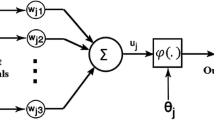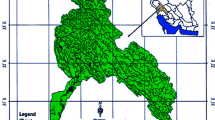Abstract
This paper describes the application of multi-layer perceptron (MLP), radial basis network and adaptive neuro-fuzzy inference system (ANFIS) models for computing dissolved oxygen (DO), biochemical oxygen demand (BOD) and chemical oxygen demand (COD) levels in the Karoon River (Iran). Nine input water quality variables including EC, PH, Ca, Mg, Na, Turbidity, PO4, NO3 and NO2, which were measured in the river water, were employed for the models. The performance of these models was assessed by the coefficient of determination R 2, root mean square error and mean absolute error. The results showed that the computed values of DO, BOD and COD using both the artificial neural network and ANFIS models were in close agreement with their respective measured values in the river water. MLP was also better than other models in predicting water quality variables. Finally, the sensitive analysis was done to determine the relative importance and contribution of the input variables. The results showed that the phosphate was the most effective parameters on DO, BOD and COD.





Similar content being viewed by others
References
ASCE Task Committee (2000a) Artificial neural networks in hydrology. I: preliminary concepts. J Hydrol Eng 5(2):115–123. doi:10.1061/(ASCE)1084-0699(2000)5:2(115)
ASCE Task Committee (2000b) Artificial neural networks in hydrology. II: hydrologic applications. J Hydrol Eng 5(2):124–137. doi:10.1061/(ASCE)1084-0699(2000)5:2(124)
Badripour H (2006) Country pasture/forage resource profiles. FAO, Rome
Bandyopadhyay G, Chattopadhyay S (2007) Single hidden layer artificial neural network models versus multiple linear regression model in forecasting the time series of total ozone. Int J Environ Sci Technol 4(1):141–149
Basant N, Gupta S, Malik A, Singh KP (2010) Linear and nonlinear modeling for simultaneous prediction of dissolved oxygen and biochemical oxygen demand of the surface water—A case study. Chemometr Intell Lab Syst 104:172–180
Bateni SM, Borghei SM, Jeng DS (2007) Neural network and neuro-fuzzy assessments for scour depth around bridge piers. Eng Appl Artif Intell 20:401–414
Broomhead D, Lowe D (1988) Multivariable functional interpolation and adaptive networks. Complex Syst 2:321–355
Chang FJ, Chen YC (2003) Estuary water-stage forecasting by using radial basis function neural network. J Hydrol 270:158–166
Chau KW (2006) A review on integration of artificial intelligence into water quality modeling. Mar Pollut Bull 52:726–733
Chaves P, Kojiri T (2007) Conceptual fuzzy neural network model for water quality simulation. Hydrol Process 21:634–646
Comer PJ (1996) Wetland trends in Michigan since 1800: a preliminary assessment. United States. Environmental Protection Agency, Michigan. Land and Water Management Division. Michigan Natural Features Inventory, Lansing
Cox BA (2003) A review of dissolve oxygen modeling techniques for lowland rivers. The Sci Total Environ 314–316:303–334
Eberhart RC, Dobbins RW (1990) Neural network PS tools: a practical guide. Academic press, San Diego
Faruk DO (2010) A hybrid neural network and ARIMA model for water quality time series prediction. Eng Appl Artif Intell 23:586–594
Fausett L (1994) Fundamentals of neural networks: architectures, algorithms, and applications. Prentice-Hall, Englewood Cliffs, NJ
Fernando AK, Jayawardena AW (1998) Runoff forecasting using RBF networks with OLS algorithm. J Hydrol Eng ASCE 3:203–209
Fletcher D, Goss E (1993) Forecasting with neural networks: an application using bankruptcy data. Inf Manag 24:159–167
Haykin S (1999) Neural network a comprehensive foundation. Prentice-Hall, New Jersey
Jang JSR (1993) ANFIS: adaptive-network-based fuzzy inference system. IEEE Trans Syst Man Cybern 23:665–685
Jang JSR, Sun CT, Mizutani E (1997) Neuro-fuzzy and soft computing: a computational approach to learning and machine intelligence. Prentice Hall, Upper Saddle River, NJ
Karamouz M, Mahjouri N, Kerachian R (2004) River water quality zoning: a case study of Karoon and Dez River system. Iran J Environ Health Sci Eng 1:16–27
Kisi O (2007) Stream flow forecasting using different artificial neural network algorithms. J Hydrol Eng ASCE 12:532–553
Klein L, Erichsen Jones JR, Hawkes HA, Downing AL (1962) River pollution, causes and effects II. Butterworths and Co (Publishers) Ltd., London, p 456
Kuo JT, Hsiehb MH, Lungc WS, Shed N (2007) Using artificial neural network for reservoir eutrophication prediction. Ecol Model 200:171–177
Kuok KK, Harun S, Shamsuddin SM (2009) Particle swarm optimization feedforward neural network for modeling runoff. Int J Environ Sci Technol 7(1):67–78
Leonardis A, Bischof H (1998) An efficient MDL-based construction of RBF networks. Neural Netw 11:963–973
Matlab User Manual (2008) Fuzzy Logic Toolbox software with Matlab
May RJ, Maier HR, Dandy GC, Fernando TMKG (2008) Non-linear variable selection for artificial neural networks using partial mutual information. Environ Model Softw 23(10–11):1312–1326
McCulloch WS, Pitts W (1943) A logical calculus of the ideas imminent in nervous activity. Bull Math Biophys 5:115–133
Modarres R, De Paulo Rodrigues da Silva V (2007) Rainfall trends in arid and semi-arid regions of Iran. J Arid Environ 70:344–355
Najah A, Elshafie A, Karim OA, Jaffar O (2009) Prediction of Johor River water quality parameters using artificial neural networks. Eur J Sci Res 28:422–435
Orr JL (1996) Introduction to radial basis function networks. Technical report, Institute of Adaptive and Neural Computation. Edinburg University. http://www.anc.ed.ac.uk/mjo/papers/intro.ps
Palani S, Liong SY, Tkalich P (2008) An ANN application for water quality forecasting. Mar Pollut Bull 56:1586–1597
Qnet 2000 (1999) Qnet 2000 neural network modelling for windows 95/98/NT, QnetToll User’s Guideand Datapro User’s Guide, Vesta Services, Inc., USA
Ranković V, Radulović J, Radojević I, Ostojić A, Čomić L (2012) Prediction of dissolved oxygen in reservoirs using adaptive network-based fuzzy inference system. J Hydroinform 14(1):167–179
Raziei T, Daneshkar Arasteh P, Saghfian B (2005) Annual rainfall trend in arid and semi-arid regions of Iran. ICID 21st European Regional Conference 2005. 15–19 May 2005
Rumelhart DE, Hinton GE, Williams RJ (1986) Learning internal representation by error back propagation. In: Rumelhart DE, McClelland JL (eds) Parallel distributed processing. MIT Press, Cambridge, MA, pp 318–362
Shi IJ (2000) Reducing prediction error by transforming input data for neural networks. J Comput Civil Eng 14:109–116
Singh KP, Basant A, Malik A, Jain G (2009) Artificial neural network modeling of the river water quality, a case study. Ecol Model 220:888–895
Soyupak S, Karaer F, Gürbüz H, Kivrak E, Sentürk E, Yazici A (2003) A neural network-based approach for calculating dissolved oxygen profiles in reservoirs. Neural Comput Appl 12:166–172
Talib A, Amat MI (2012) Prediction of chemical oxygen demand in Dondang River using artificial neural network. Int J Inf Educt Technol 2(3):259–261
Venkatesan P, Anitha S (2006) Application of a radial basis function neural network for diagnosis of diabetes mellitus. Curr Sci 91:1195–1199
Verma AK, Singh TN (2013) Prediction of water quality from simple field parameters. Environ Earth Sci 69(3):821–829. doi:10.1007/s12665-012-1967-6
Wang J, Sui J, Guo L, Karney BW, Jüpner R (2010) Forecast of water level and ice jam thickness using the back propagation neural network and support vector machine methods. Int J Environ Sci Technol 7(2):215–224
Wasserman PD (1989) Neural computing: theory and practice. Van Nostrand Reinhold, New York
Xiang SL, Liu ZM, Ma LP (2006) Study of multivariate linear regression analysis model for ground water quality prediction. Guizhou Sci 24:60–62
Yilmaz I, Kaynar O (2011) Multiple regression, ANN (RBF, MLP) and ANFIS models for prediction of swell potential of clayey soils. Expert Syst Appl 38:5958–5966
Zhang H, Li S (2010) Effects of physical and biochemical processes on the dissolved oxygen budget for the Pearl River Estuary during summer. J Mar Syst 79(2):65–88
Acknowledgments
The authors would like to thank Khozestan Water and Power Authority (KWPA) of Iran for the provided data.
Author information
Authors and Affiliations
Corresponding author
Rights and permissions
About this article
Cite this article
Emamgholizadeh, S., Kashi, H., Marofpoor, I. et al. Prediction of water quality parameters of Karoon River (Iran) by artificial intelligence-based models. Int. J. Environ. Sci. Technol. 11, 645–656 (2014). https://doi.org/10.1007/s13762-013-0378-x
Received:
Revised:
Accepted:
Published:
Issue Date:
DOI: https://doi.org/10.1007/s13762-013-0378-x




